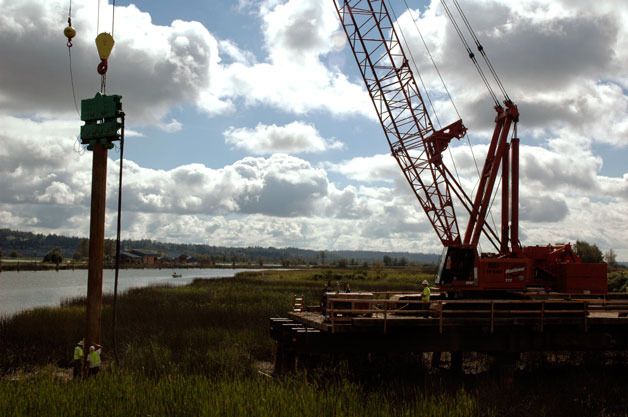MARYSVILLE — Drivers on State Route 529 have already dealt with several closures and detours on the existing 85-year-old Ebey Slough Bridge since construction started on its replacement near the end of July, but Washington State Department of Transportation representatives assured motorists that the end results would be worth it.
Passersby have recently seen construction crews on the east side of the existing Ebey Slough Bridge driving piles into the edges of the slough itself, which WSDOT Project Engineer Janice Fahning explained is part of the first stage of the project.
“We use a vibratory hammer to vibrate the steel piles into the soil,” Fahning said, as a crane on the south side of Ebey Slough attached the pile driver to the top of a 50-foot-long steel pile, before swinging it over to the mark where it would be driven into the ground. “Another 50-foot pile will be welded to it once it gets deep enough, so the piles will go down 100 feet.”
These piles are not being placed to support the new bridge, but rather, to support the temporary work platform from which the foundation, substructure and superstructure for the new bridge will be built. The existing bridge will remain in place until the new bridge is completed, so the new bridge will be built between the existing bridge and the temporary work platform.
“It’ll extend into the channel a little way, but not that much,” WSDOT Chief Inspector Joe Rooney said. “We can’t have our equipment sitting in the wetlands. This work trestle will be removed once we’re done. We’ve already had people look at it and say, ‘Man, that’s one ugly bridge,’” he laughed. “What they see now is not the new bridge, though. This is all just temporary.”
Rooney noted that the channel’s water quality is tested on an hourly basis to ensure that construction work is not causing turbidity, and added that the water has checked out as clean every time. Fahning elaborated that construction crews would remove the lead paint and timber creosote piles of the existing bridge, and install new stormwater treatment systems, including grassy swales, to help filter pollution.
The work platform, while temporary, still needs to be able to bear the weight of cranes and girders. Construction crews plan to drive in permanent piles for the new bridge in October. The permanent piles for the bridge will be twice the size of the temporary piles for the work platform, going more than 200 feet deep.
“We use stone columns to compact the below-ground soil,” Fahning said. “By making it denser, we’re reinforcing it against earthquakes and other movement.”
According to Rooney, Granite Construction has had an average of 50 workers on site on a daily basis.
“They’re building this new bridge for $21.5 million, which is 23 percent below our estimated cost,” Fahning said. “We’re getting a great price and putting people to work from local contractors and subcontractors. In less than two years from the start of construction, we expect to have drivers on the new bridge by the spring of 2012.”
The project is divided up into three stages, with the current first stage wrapping up in February of 2012. While all traffic will continue to use the existing Ebey Slough Bridge during stage one, northbound traffic will move to the new bridge during stage two, as construction crews realign SR 529 from the old bridge to the new bridge. Stage three kicks off in April of 2012 and is set to run to February of 2013, during which construction crews will remove the old bridge, complete the final paving and striping in the project area, and move all traffic to the new bridge.
The new bridge will have two lanes in each direction, with separate bicycle lanes and sidewalks on each side of the bridge. It will be a taller fixed-span bridge, rather than a swing-span bridge. Before August, the existing bridge swung on its axis to allow marine traffic to pass, a process that typically took about 10 minutes and caused delays for vehicle traffic.
SR 529 is a main commuter route between Marysville and Everett. About 17,000 drivers use this section of SR 529 each day. The existing bridge is at the end of its service life, and does not meet current traffic needs. The new bridge will help reduce congestion by handling more vehicle traffic. It will also reduce the need for costly repairs and eliminate the cost of staffing the old moveable bridge.
For project details, graphics and video, visit www.wsdot.wa.gov/projects/sr529/ebeysloughbridge.



